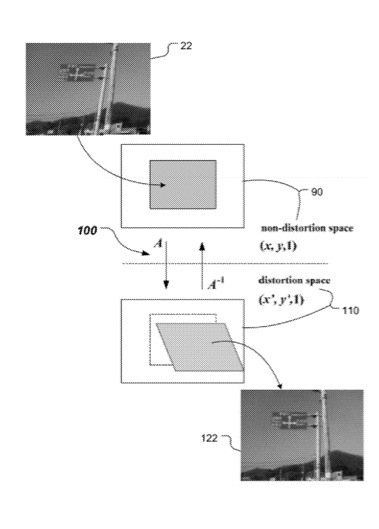An Apple patent (number 20120092559) for rolling shutter distortion correction has appeared at the U.S. Patent & Trademark Office and apparently involves the camera in the iPad. It relates to correcting for a rolling shutter distortion in digital images; for example, a video clip composed of a sequence of digital images.
Methods, systems, and apparatus, including computer programs encoded on a computer storage medium, for performing rolling shutter distortion corrections are described. A video clip captured by a user is received and each of a plurality of predefined affine transforms for rolling shutter distortion correction is applied to the received video clip. Further, a visual indication of results from each of the plurality of the predefined affine transforms is presented to the user and input is received from the user selecting one of the visual indications.
Furthermore, the predefined affine transform corresponding to the selected visual indication is associated with a device that acquired the received video clip. Additionally, the association can be stored, and the stored association can be used later to automatically perform a rolling shutter distortion correction on another video clip upon detecting that the other video clip comes from same device that already went through a calibration sequence.
Here’s Apple’s summary of the invention: “In general, one aspect of the subject matter described in this specification can be implemented in methods that include the actions of receiving a video clip and determining whether the received video clip was captured using a known video capture device. If the video capture device is determined to be known, the methods further include the actions of using a predefined affine transform associated with the known video capture device to perform a rolling shutter distortion correction. If the video capture device is determined to be unknown, the methods include the actions of prompting a user of the data processing apparatus to perform a calibration process on the unknown video capture device.
“Other aspects include corresponding computer systems, apparatus, and computer programs recorded on one or more computer storage devices, each configured to perform the actions of the methods. A system of one or more computers can be so configured by virtue of software, firmware, hardware, or a combination of them installed on the system that in operation cause the system to perform the actions. One or more computer programs can be so configured by virtue having instructions that, when executed by data processing apparatus, cause the apparatus to perform the actions.
“The foregoing and other embodiments can each optionally include one or more of the following features, alone or in combination. In some implementations, the methods can include the actions of receiving information corresponding to a result of the calibration process, and using the received information to perform the rolling shutter distortion correction for the received video clip. In some implementations, the methods can include the actions of storing the received information in a profile associated with the unknown video capture device. The stored information can include an association between the video capture device’s unique identifier and the predefined affine transform to be used for rolling shutter distortion correction.
“In some implementations, the predefined affine transform is selected from among a plurality of predefined affine transforms. For example, the plurality of predefined affine transforms includes at least four different predefined affine transforms. As another example, each of the plurality of predefined affine transforms corresponds to a different shutter speed.
“Another aspect of the subject matter described in this specification can be implemented in methods that include the actions of receiving a video clip captured by a user and applying each of a plurality of predefined affine transforms for rolling shutter distortion correction to the received video clip. Further, the methods include the actions of presenting a visual indication to the user of results from each of the plurality of the predefined affine transforms and receiving input from the user selecting one of the visual indications. Furthermore, the methods include the actions of associating the predefined affine transform corresponding to the selected visual indication to a device that acquired the received video clip.”
Randy Ubillos is the inventor.
Also appearing at the U.S. Patent & Trademark Office are two patents involving contacts on electronic devices. Patent number 20120094513 involves a shallow depth connector having contact protection. Joshua Funamura and Min Chul Kim are the inventors.
Patent number 20120094517 is for a connector having self-wiping contacts. The inventors are Zheng Gao, Greg Springer, William Long, John Raff and Laura DeForest.


